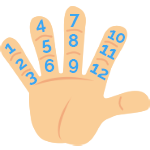In this post, we are going to talk about what a dozen is and its relation to other concepts that I’m sure you have heard in math class before.
Index
What is a dozen?
A dozen is twelve units of something in a collection together. So we can have dozens of things, for example, twelve eggs are a dozen eggs. Twelve cats are a dozen cats and twelve math problems are a dozen math problems.
A dozen dozens
I’m sure that you have heard the words tens and hundreds in math class before. Do you remember what they are? You can refresh your memory by checking out this post about units, tens, and hundreds.
Essentially, a ten is made up of ten units; a hundred is made up of ten tens, and so on. Thus, the ten and the hundred appear when adding a zero to the unit and are very useful for characterizing three-digit numbers easily. For example, the number 360 is composed of 3 hundreds and 6 tens.
As with the hundreds, which are ten tens, we can similarly consider what a dozen dozens are. After a simple calculation, we find that 12 x 12 = 144 and, consequently, a dozen dozens is composed of 144 units. A dozen dozens is known as a “gross.”
Any large number can be expressed by using a dozen as a reference. For example, 360 = 2 x 144 + 6 x 12. This 360 is equal to 2 grosses and 6 dozens. The way of numbering is known as the duodecimal, or dozenal, system.
Although it may be strange and obscure, the dozenal system has been widely used in various cultures. And we still find traces of its use today, like with the months of the year. It is believed that its use was natural for humans because, using one hand, you can count to 12 by using your thumb to count each of the three phalanges of the remaining four fingers. That way, if you use both hands you can count to 24 while just using whole fingers you can only count to 10.

Dozens and the Sexagesimal System
Previously we said that we can count to 12 on one hand, but what do we do with the other hand? If we use the other hand to count dozens since we have 5 fingers, we could count 5 dozens which is 60. It is believed that the Babylonians chose the sexagesimal system to count sixty in sixty, which is the system that we have inherited to measure angles in geometry and the minutes and seconds in time – in addition to using it for the 12 hours on a clock.
Is the decimal system or dozen system better?
Imagine that we are making a recipe in the kitchen that calls for four eggs. We go to the store to buy eggs and we find that they only come in ten tens or a dozen dozens. What works better for us?
We think we should buy the ones that come in ten tens, in other words, a ten of eggs. We make the recipe and see that we have six eggs left but it turns out that we like the recipe, so we make it again and now have two eggs leftover and don’t know what to do with them.
It is true that it would not be a serious problem because we can always make two fried eggs for dinner. However, if we run a warehouse and need to decide how to pack tons of eggs, it becomes a bit more serious.
The number 10 has four divisors: 1, 2, 5 and 10. Whereas 12, can be divided by 1, 2, 3, 4, 6, and 12. Therefore, a dozen is much more convenient when making deliveries and storing objects.

Let’s end with a fun fact!
Although we know that a dozen is made up of 12 units, there is a rare exception where it is not. In the medieval Anglo-Saxon world, bakers that deceived their clients were severely punished. To eliminate this they decided to include an extra unit with the dozens of loaves they sold so that they would avoid falling short and no one could criticize them for an alleged bad faith in their trade.
Therefore, a set made up of 13 units is sometimes referred to as a baker’s dozen. Do you dare try to figure out what a baker’s dozen of baker’s dozens would look like?
I hope that you have enjoyed this post and have learned something interesting. If you would like to continue learning elementary mathematics, adapted to your level, join the Smartick community, what are you waiting for?!
Learn More:
- Tens and the Decimal Number System
- Learn about Fractions: Halves, Thirds and Fourths
- Ones, Tens, Hundreds. Learn How They Are Used
- Do You Want to Learn Multiplication Tables Tricks?
- Learn Multiplication Algorithm Using Blocks







